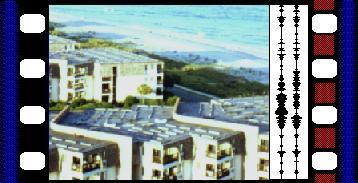
35mm film is the standard film format that most theaters use. Below is what a frame of 35mm film looks like. Most of the film is taken up by the image, but the film also has the movie's sound track on it.

The 2 squiggley lines to the right of the image are the 2 channel analog soundtrack. They are simply 2 lines that look like WAV files that you might find on your computer. Each line is one channel of sound, together they are Left and Right. Nearly all 35mm projectors are set up for this "stereo sound". Of course 2 channels of analog is pretty old fashioned in this digital age. Most modern Mega-Plexes (big theater complexes) have set-ups for multi-channel digital sound. Their are several types of digital sound system. Theaters have special decoders that attach to their projectors to decode and play digital sound. NOTE: These decoders do not replace 2-channel analog completely. The digital decoder is added to a projector in addition to (not in place of) Analog. The reason that analog is still important is because some rare movies (usually foreign or art films) do not have digital sound. Also if the Digital sound area on a film is damaged (which can happen when running a film print through projector sprockets 5 times a day, 7 days a week) the projector can automatically switch back to 2 channel analog until it gets passed the damaged portion of the film.
The red and Blue tint near the sprocket holes on this frame represents the Digital Sound. The sound is simply converted into binary code (meaning a series of 1s &0s that represent the sound. Those data bits are microscopically printed onto that area of the film. A digital decoder can read these digital bits and convert them back into sound. These digital sound decoders bolt onto the top of the projector and the projectionist threads the film through them when threading the projector.
The red area between the right sprocket holes is the Dolby Digital 5.1 soundtrack. Dolby Digital uses 5.1 channels of sound (Center, Front-Left, Front-Right, Rear-Left, Rear-Right) The .1 is a channel that only carries low rumblings (sometimes called the "sub-woofer channel") it uses 10% of the bandwidth of any of the other channels.
The blue area on the outer edges of the sprocket holes is the SDDS (Sony Dynamic Digital Sound). SDDS is the most advanced of the major theater systems, and the most expensive. Unlike Dolby Digital the data bits are printed onto a wider area (because it is beside the holes instead of between them.) This results in higher bandwidth which means less compression and more channels, 8 as opposed to 5.1. In reality one of those channels is a "sub woofer channel" meaning that SDDS could be called 7.1. The SDDS channels are Center, Left-Center, Right-Center, Left-Front, Right-Front, Right-Rear, Left-Rear. The tracks on the left and the right side of the film both contain identical copies of all 8 channels. This is so that if one side is damaged it can seamlessly switch to the other. If both are damaged it must switch back to 2 channel analog, but the chances of both sides being damaged in the same place are low.
A third type of Digital sound is DTS (Digital Theater Sound). DTS uses 5.1 channels (like Dolby Digital) but the data is not printed onto the film. The Data is on a CD (or 2 or 3 CDs depending on the film's length) Their is a time code on the film which the CD is synchronized to. (NOTE: The time code means that if a part of the film is removed, which can happen if it breaks or gets chewed up in the gears, the CD will remain in-sync with the movie because the time code will tell the decoder to jump ahead on the CD and skip the missing few seconds.) If the CD did not remain synched to the movie 1 second of film being removed would result in the sound no longer matching the actors' lip movements. The advantage of DTS over Dolby 5.1 is that the Dolby track had to be compressed to fit between the sprocket holes which results in a lower band width. Since the DTS is on a CD it needs less compression, which means better sound. A DTS decoder comes in two parts. One part bolts on top of the projector where the film is threaded (like a smaller version of the Dolby Digital and the SDDS units) which only reads the film's time code. The other part looks like a PC with 2 or 3 CD-ROM drives in it, which plays the 5.1 channel CDs in-sync with the film.
Copyright 2000 by:
Brian Fitzgerald